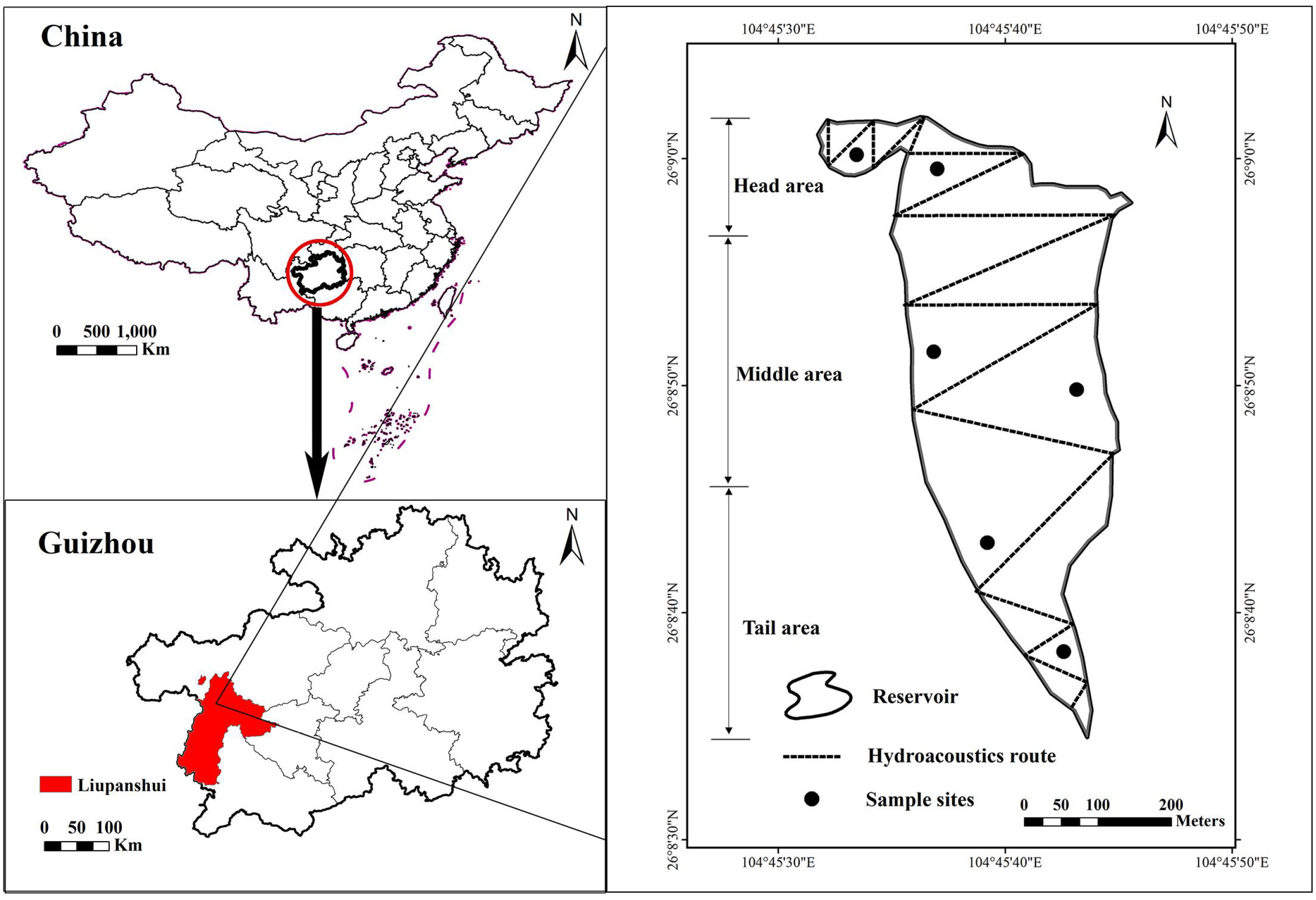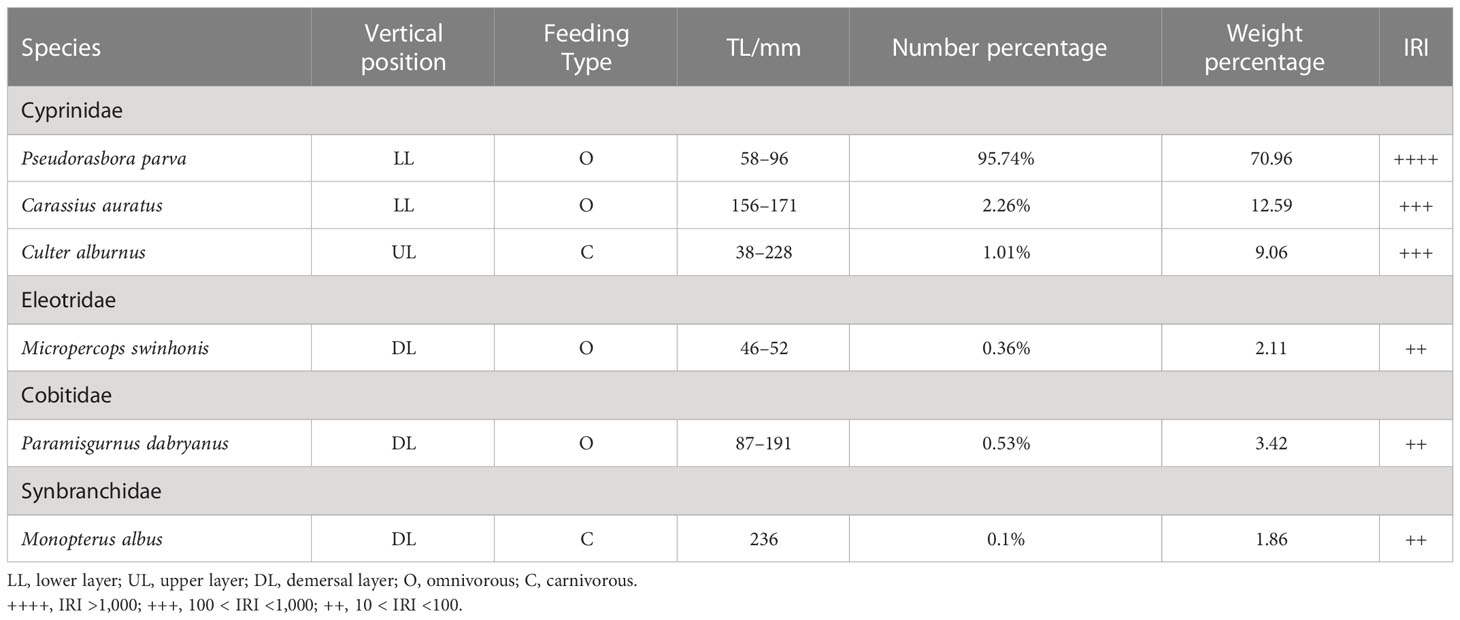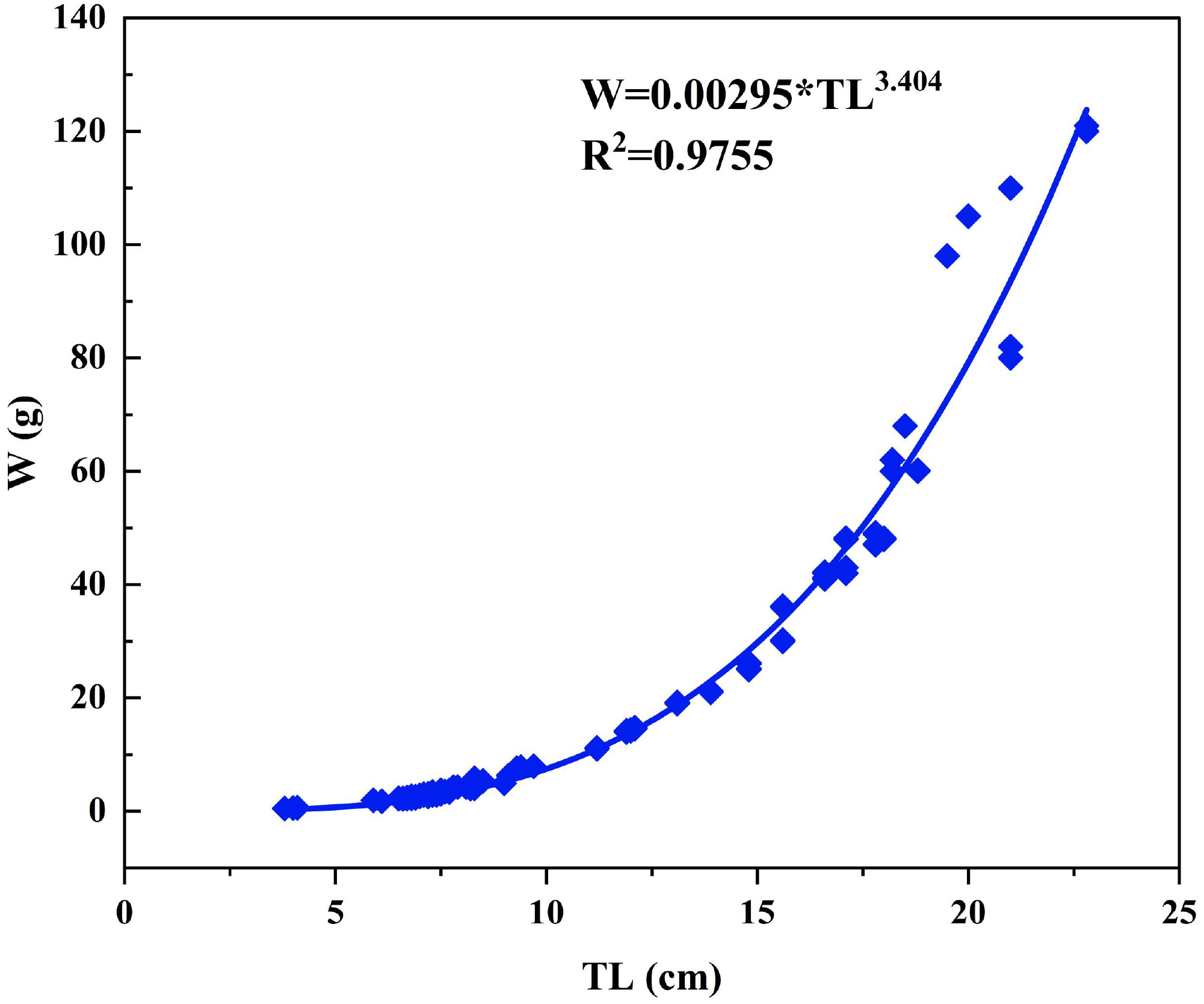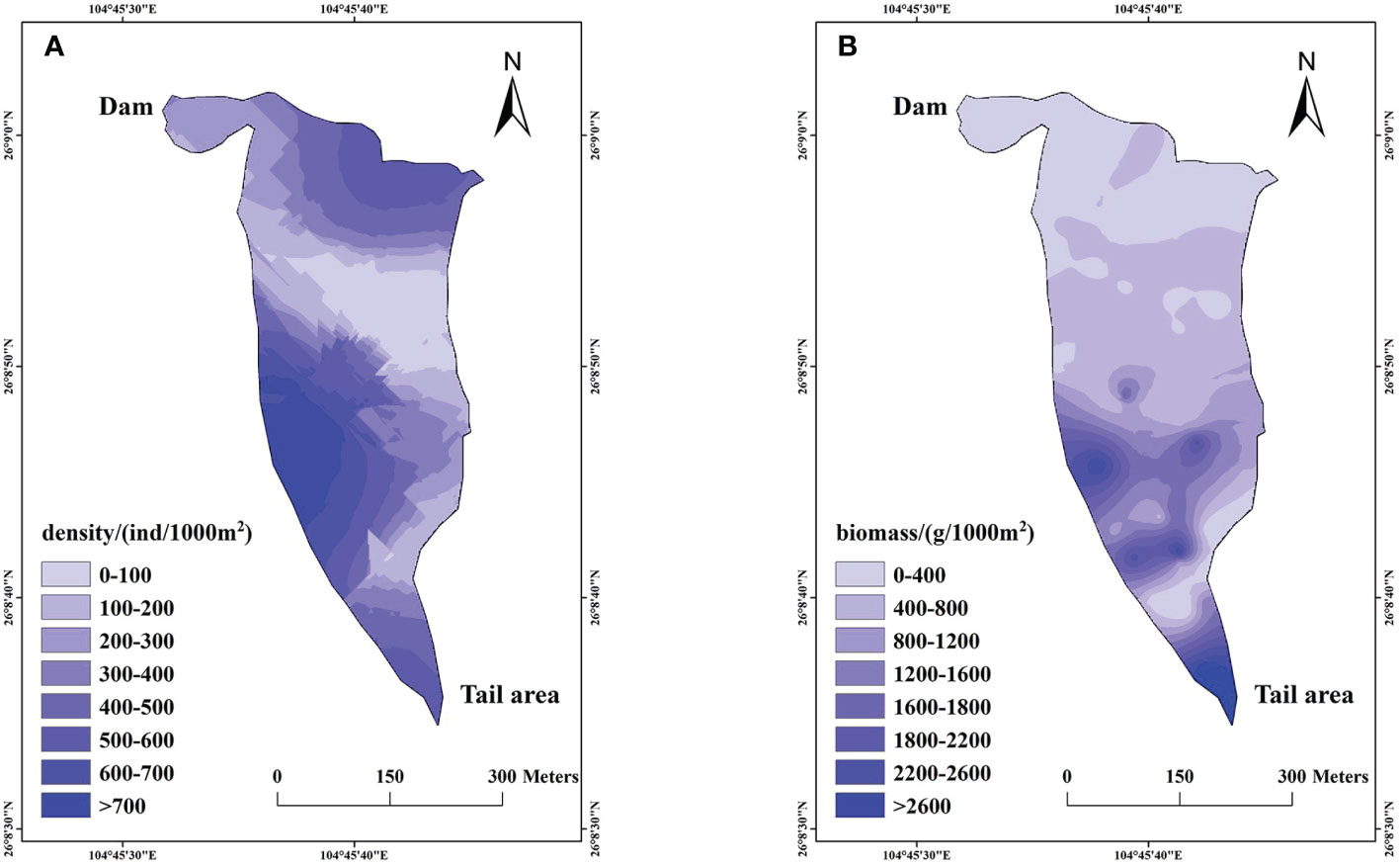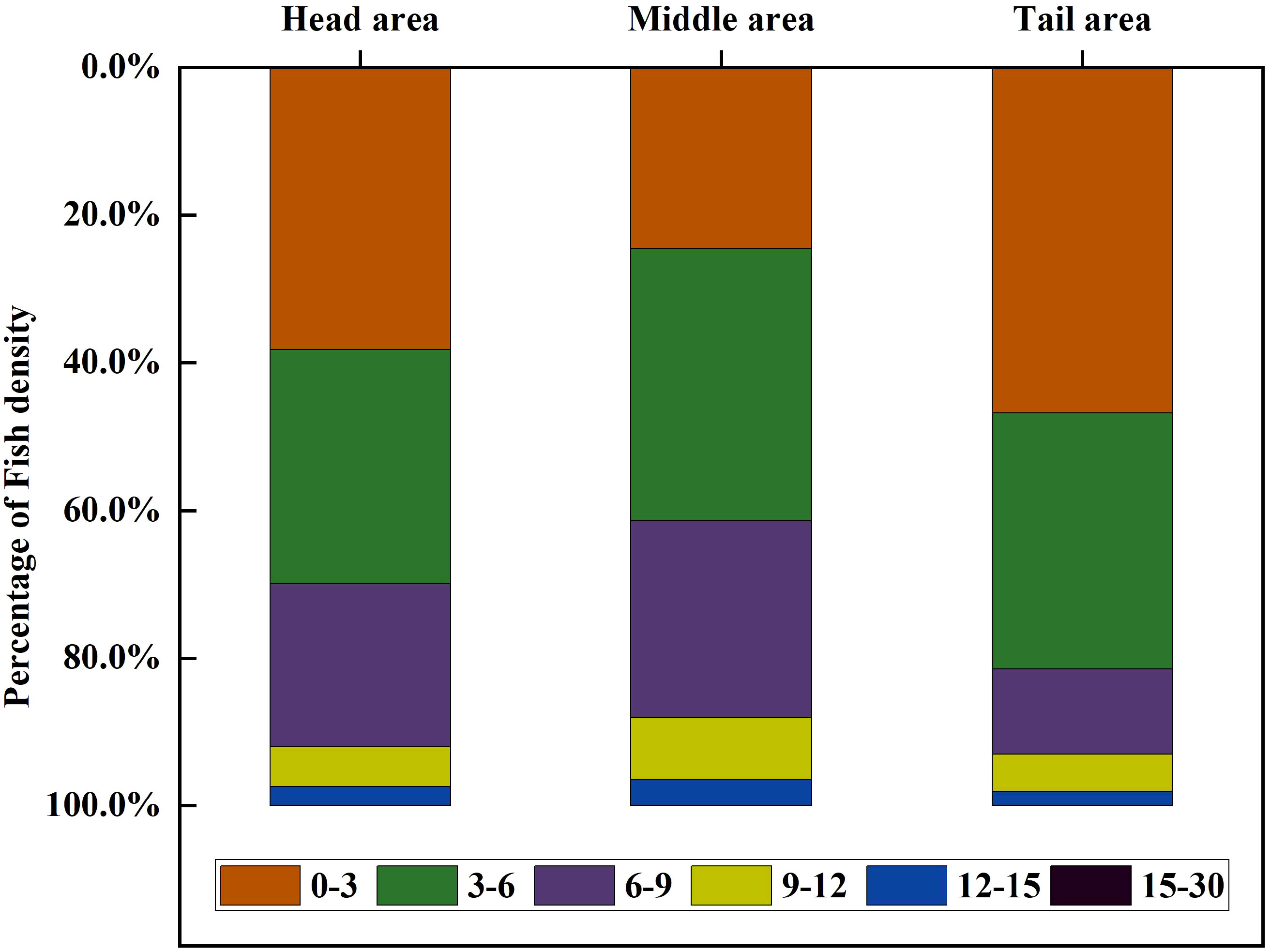- 1College of Animal Science, Guizhou University, Guiyang, China
- 2State Key Laboratory of Freshwater Ecology and Biotechnology, Institute of Hydrobiology, Chinese Academy of Sciences, Wuhan, China
- 3College of Advanced Agricultural Sciences, University of Chinese Academy of Sciences, Beijing, China
- 4School of Life Sciences, Nanchang University, Nanchang, China
- 5College of Life Science, Anqing Normal University, Anqing, China
- 6College of Fisheries, Huazhong Agricultural University, Wuhan, China
Understanding the fish community structure and spatial distribution characteristics is essential for appropriate reservoir fishery management, especially in the early impoundment stage of the reservoir, which could help in obtaining basic data and performing artificial adjustments to biological communities. On the basis of this concept, we conducted a survey of the fish community and distribution at the newly constructed reservoir in southwest China by using a combination of methods, including hydroacoustic survey and fish sampling. Fish sampling showed a single fish community structure (six species belonging to four families) assembled in the reservoir, and the dominant species was Pseudorasbora parva which accounted for 98.79% of the fish population. In the hydroacoustic survey, the average fish density was 318.7 ± 256.1 individuals/1,000 m2. Irregular distribution of the fish was observed in the horizontal direction. The fish densities in the head area, middle area, and tail area of the reservoir were 168.5 ± 60.1, 306.8 ± 124.7, and 696.4 ± 288.9 individuals/1,000 m2, respectively, which showed a trend of increase in fish density with an increase in distance from the dam. More than 97.3% of the fish in the vertical direction were distributed in the water layer of depth 0 to 12 m. The average total length of fish was 75.4 mm, and the mean fish biomass in the reservoir was approximately 984.8 g/1,000 m2. According to Pearson correlation analysis, the main factors affecting the spatial distribution of fish were water depth, water temperature, dissolved oxygen, total nitrogen, and plankton density. Our results suggested that the fish community structure should be adjusted by releasing native carnivorous fish to control the abundance of small fish. Moreover, filter-feeding fish such as silver carp and bighead carp should be released in the reservoir to control the plankton community; this will enable the maintenance of the reservoir ecosystem in a healthy state while increasing the economic benefits to the local area.
1 Introduction
The increasing demand for water resources, combined with the nonuniform temporal and spatial distribution of precipitation, has resulted in severe water shortage in many parts of the world. Reservoirs, as important and effective means for ensuring adequate water resources, not only supply water for humans, enable the generation of hydroelectric energy, and prevent floods but also play an important role in fisheries and aquaculture (Prchalová et al., 2009; He, 2016). Among the different types of aquaculture, reservoir aquaculture is an important method of aquaculture in Guizhou Province, China. Based on the data from the China Fisheries Statistical Yearbook (Bureau of Fisheries, 2021), the reservoir aquaculture area in Guizhou Province accounted for 19.1% of the total aquaculture area in the province, while the output of aquaculture products in reservoirs constituted 23.1% of the total output in 2020. During the early operation period, the reservoir had a relatively homogeneous ecosystem and healthy quality of water (Han, 2010). However, because of dam construction, the velocity of the incoming water flow decreased, and the hydraulic retention time extended, which changed the original runoff characteristics of the water. Moreover, the industrial pollution sources around the reservoir area, domestic waste discharge, and other sources of pollution from the watershed enrichment increased the eutrophication in many reservoirs so that it further declined the quality of the water. It not only affected the production but also raised concerns regarding water safety for residents (Wu et al., 2012; Guo et al., 2018). To maintain the quality of large water bodies such as lakes and reservoirs, to reduce the loss of ecosystem energy, and to exploit the productive potential of water bodies, filter-feeding fish such as silver carp (Hypophthalmichthys molitrix) and bighead carp (Aristichthys nobilis) have been widely released into the water (Liu and Xie, 2003; Guo et al., 2015). It has therefore become crucial to conduct an assessment of fishery resources to determine appropriate methods to enhance the fish population and release them in a scientific and rational manner (Liu and Zhang, 2016).
There is a pressing need for knowledge of reservoir ecosystems in fishery management and monitoring water quality. Hydroacoustics is an effective tool to understand the dynamics of freshwater ecosystems, and many studies have applied hydroacoustics in their investigations. Hydroacoustics has been developed over several decades, and it is presently recognized as a robust and reliable method for fish assessment (Drastik et al., 2017; Anne et al., 2019). Traditional methods of fishery resource surveys, such as sampling fishes by gillnets, electricity, purse seine, or trawlnet, are based on rough estimates of the number and weight of catches, which are time-consuming and error-prone when implemented in deep reservoirs (Xie et al., 2003; Maclennan and Simmonds, 2005; Kubečka et al., 2009). Compared with the passive survey method, the hydroacoustic survey can provide long-term, continuous, and abundant fishery resource data; thus, this method has the advantages of highly efficient and nondestructive approach to the survey object and relatively low labor cost (Maclennan and Simmonds, 2005; Guillard et al., 2012; Winfield et al., 2013). Recent advances in hardware and software have enabled the more widespread use of hydroacoustic methods, which are more suitable for open water systems such as deep lakes and reservoirs (Godlewska et al., 2004; Anne et al., 2019). Hydroacoustic survey has been widely used in fishery resource assessment, fish behavior assessment, and aquatic plant and plankton research in large water bodies in China and abroad (Lian et al., 2015; Samedy et al., 2015; Anne et al., 2019).
Guizhou Province is located in the eastern part of the Yunnan-Kweichow Plateau, and 92.5% of its region is mountainous and hilly, which has a typical karst landform and constitutes a unique karst ecosystem in southwest China, resulting in poor soil quality and easy infiltration of surface water. Consequently, there are fewer natural lakes, thereby leading to a very severe water shortage, particularly in mountainous areas (Lv, 2019). To resolve this water shortage issue, the government has constructed several reservoirs. Reservoirs are an important water resource for ensuring an adequate water supply and the preservation of the natural environment in Guizhou (Ou, 2015; Lv, 2019). In the present study, we chose Yuwanghe Reservoir in southwest China as the study case. By using the hydroacoustic survey as the main tool, combined with the fish catch sampling method, we obtained the spatial distribution pattern and resources of fish at the early stage of the reservoir with an aim to provide a theoretical basis and technical support for reservoir management and development in the Yunnan–Guizhou region.
2 Materials and methods
2.1 Study area
Yuwanghe Reservoir is located in the northern part of Liupanshui, Guizhou Province; it belongs to Yuwanghe River, which is a first-class tributary of the Beipan River and is situated approximately 50 km from Shuicheng County (26°08ʹ30–26°09ʹ02N, 104°45ʹ30—104°45ʹ50E; Figure 1). The reservoir started to store water and began its operation in 2020 with a maximum depth of 42.3 m and an average depth of 18.8 m. The average capacity is 1.022 × 107 m3. The main function of the reservoir is to provide water and irrigation facilities to the residents of the area. To analyze the horizontal distribution of fish assemblages, the reservoir was divided into three sections —namely, head area, middle area, and tail area —on the basis of its geographical features.
2.2 Hydroacoustic measurements
The hydroacoustic survey was conducted during daylight hours in May 2021. A DT-X split-beam echosounder (BioSonics, Seattle, WA, USA) operating at a frequency of 200 kHz was used, with a transducer beam angle of 6.8° × 6.8°. The transducer was mounted on the starboard side of the vessel at a distance from the bow equal to one-third of the hull length; thus, the transducer could reach a depth of 0.5 m below the water. The vertical geographic position and the hydroacoustic route of the beam were recorded in real-time by Garmin GPS 17×HVS. The echosounder was connected to a laptop to display and store the hydroacoustic data in real-time by using Acquisition 6.0 software. Water temperature and salinity data required for the data acquisition program were determined using the YSI6600V2 multiparameter water quality monitor. To reduce the impact of vessel noise on the survey, the hydroacoustic survey was conducted along zigzag transects, with the vessel sailing at the speed of approximately 6–8 km·h–1 (Lian et al., 2018). The survey started from the head area of the reservoir and ended at the tail area (Figure 1). The route covered the entire reservoir. The investigation was repeated twice back and forth to ensure coverage of more than 6% (Matthias et al., 2012).
2.3 Fish sampling captures
Fish catch surveys were conducted to obtain the fish composition and community structure; the aim of these surveys was to determine the consistency between the hydroacoustic survey signals and the distribution of fish body length. Six fish sampling sites were selected, including two sites each at the head, middle, and tail areas (Figure 1). Composite gillnets of multiple meshes (50 m in length and 3 m in height; mesh size of 1.0, 1.6, 2.0, 2.5, 3.1, 4.0, 4.8, 6.0, 7.5, 8.5, 11.0, and 12.5 cm), trammel gillnets (200 m in length and 5 m in height; mesh size of 6.0, 8.0, 10.0, and 12.0 cm), and floor cage net (20 m in length, 0.4 m in width, 0.4 m in height, and mesh size of 5 mm) were used for the field sampling. The floor cage nets were installed in the coastal zone near each sample site at a position as distant as possible. The gillnets were installed at each sample site in the main area. The nets were set for 12 h from 17:00 to 5:00. Fish catches were identified, measured, and counted in fresh condition. Species identification was performed by referring to the guidelines of the Zoology of China (Chen, 1998; Yue, 2000). Spatial and trophic ecological niche classification was performed by referring to the Guizhou Fish Journal (Wu, 1989). Measurements were performed at the accuracy level of 1 mm in length and 0.01 g in weight.
2.4 Environmental variables
Quantitative samples of plankton and water were collected along with the catch collection. The plankton samples obtained from the mixtures of the bottom, middle, and surface water at each site were collected in 50- ml polyethylene bottles, and 1 ml of formaldehyde solution was added for preservation. The samples were then stored for laboratory tests (Zhang and Huang, 1991). Water samples were collected in 1, 000- ml black polyethylene bottles at a surface water depth of 0.5 m. The samples were brought to the laboratory under low temperature conditions to measure the content of total nitrogen, total phosphorus, ammonia nitrogen, and chlorophyll a. Water depth was measured based on acoustic signals. Water temperature, pH, dissolved oxygen, and conductivity were measured on site by using a YSI 6600V2 multiparameter water quality monitor (Zhang and He, 1991). A transparency disk was used to measure the water transparency.
2.5 Hydroacoustic data processing and analysis
The hydroacoustic data were converted and post-processed with Visual Analyzer version 4.3 software. Because the fish signals from the echosounder were scattered, the blind areas of detection and areas with high interference at 1 m below the level of the transducer and 0.5 m above the bottom of the probe were artificially eliminated; this step minimized the effect of noise (Li et al., 2022; Lian et al., 2022). The echograms of all survey sections were carefully examined and manually edited to regenerate the bottom surface if required. Background noise beyond the target signal, such as bubbles and noise interference from ships, was manually eliminated based on the characteristics of the echogram (Huang et al., 2019). To shield the echo signal from weak scatterers such as plankton, the minimum threshold in the target intensity echo image was set to –70 dB.
The total length of the fish was derived from the empirical formula (TS - TL) of target strength (TS) and total length (TL) of carp as proposed by Frouzova et al. (2005):
where TS is the target strength of the fish body, TL is the total length of the fish, and 103.9 is a constant value.
The conversion between the t otal length and the fish weight is based on the relational expression obtained by applying the power function W = a*TLb (W is the fish weight and a and b are the parameters) to fit the total length and weight of the fish catch samples (Ricker, 1975; Ye et al., 2007).
The biomass for each transect was calculated by multiplying the average fish numerical density estimated acoustically with the weight corresponding to the average TS for this transect. The total biomass for the given area was calculated as a weighted mean.
2.6 Statistical analysis
The goodness of fit between fish catch samples and hydroacoustic data was analyzed by Mann–Whitney U-test. The differences between areas for mean fish density and fish biomass were analyzed with two-sample t-test. Pearson correlation coefficient was used to determine the correlation of fish spatial distribution and environmental factors. All analyses were completed with the OriginPro 2021 (OriginLab, 2021) and ArcGIS 10.2 software (Esri, 2013).
3 Result
3.1 Composition of fish catches
In the survey of fish catches, six species of fishes belonging to three orders and four families were found in Yuwanghe Reservoir, and a total of 1,892 fish were sampled. The status and the role of species in the community were classified according to their number and the weighted proportion of catches. Species with an index of relative importance (IRI) > 1,000 are defined as dominant, those with IRI between 100 to 1,000 are important species, those with IRI between 10 to 100 are common species, and those with IRI < 10 are occasional species (Jutagate and Sawusdee, 2022). On the basis of this criterion, topmouth gudgeon (Pseudorasbora parva) was the dominant species in the fish community, Carassius auratus and Culter alburnus were important species, and Micropercops swinhonis and Paramisgurnus dabryanus were common species (Table 1). The curve-fitting result between the total length and the weight of the fish catch samples (Figure 2) by using regression analysis showed that the relation formula was W = 0.00295*TL3.404 (R2 = 0.9755), and the fitting degree was good.
3.2 Comparison between fish catches and hydroacoustic data
The total length range of the fish catches was 38 to 236 mm. Small fishes formed the main group, with more than 96% of the fish having a total length of <100 mm. The quantitative proportion of the fish in the catches decreased rapidly with the increase in the total length. The hydroacoustic survey showed that the target strength of fish was –62 to –48 dB, which showed a fluctuation in the value (Figure 3A). The target strength was concentrated in the range of –62 to –58 dB, with a peak strength appearing at around –58 dB. The total length of topmouth gudgeon, whose population accounted for 95.74% of the total population, ranged from 38 to 96 mm. Based on the empirical formula (Eq. 1), the target strength of –56 dB was converted into a length of approximately 100 mm. Thus, it can be inferred that the acoustic signal with the target strength of <–56 dB mainly originated from topmouth gudgeon. The results of the Mann–Whitney U-test indicated no significant difference (P > 0.05) in the total length between the fish catches and the hydroacoustic data; this finding indicated a good agreement between the results of the hydroacoustic survey and the field analysis (Figure 3B).
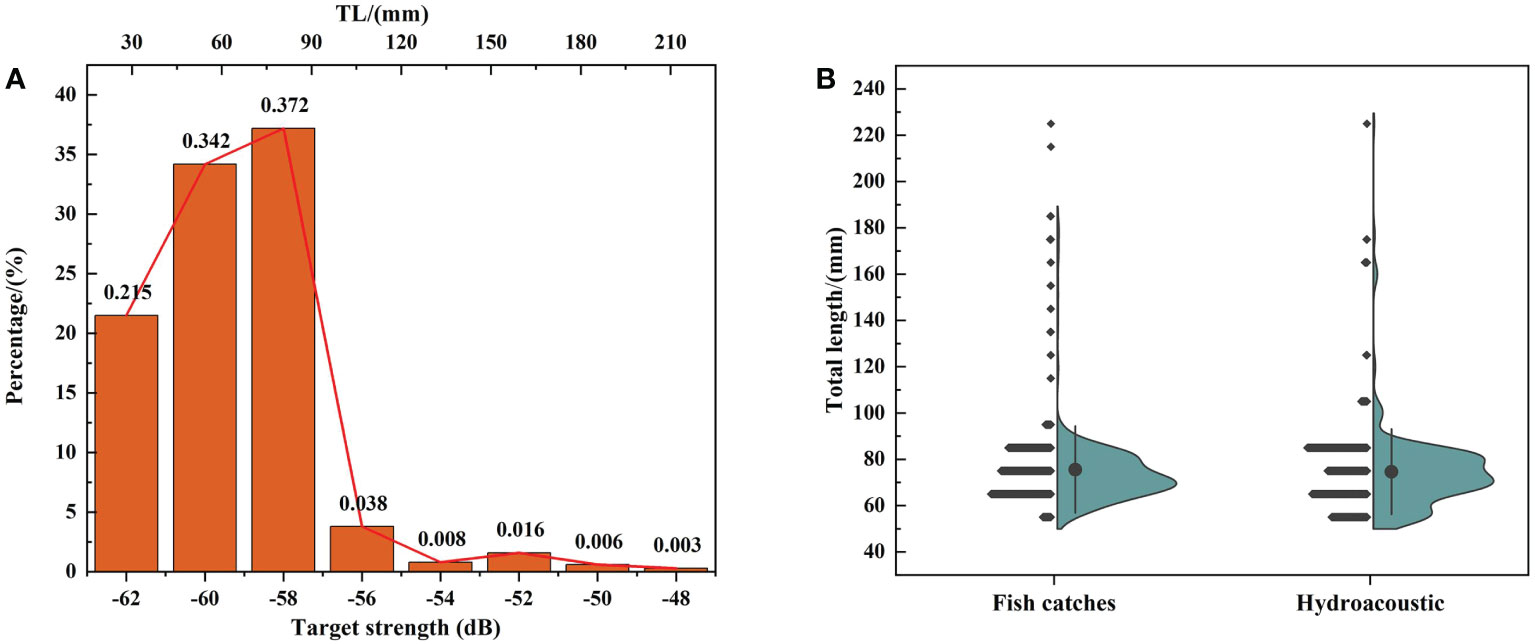
Figure 3 (A) Frequency distribution of fish target strength (TS). The bottom horizontal axis represents the intervals of TS (the width is 2 dB), the top horizontal axis represents the corresponding fish total length converted from fish target strength by empirical formula (1), and the vertical axis represents the percentage of individual fish corresponding to each interval of TS. (B) Comparison of fish catches and hydroacoustic data (fish target strength was converted to total length).
3.3 Horizontal distribution pattern of fish
The hydroacoustic survey showed an uneven horizontal distribution of fish in Yuwanghe Reservoir (Figure 4). Fish density and fish biomass were significantly varied in the different areas of the reservoir (P < 0.05). The mean fish density of the entire reservoir was 318.7 ± 256.1 individuals/1,000 m2, and the fish density tended to increase from the head area and the middle area to the tail area of the reservoir, with values of 168.5 ± 60.1 individuals/1,000 m2, 306.8 ± 124.7 individuals/1,000 m2, and 696.4 ± 288.9 individuals/1,000 m2, respectively (Figure 5A). On the basis of the W - TL relation formula and the weighted average calculation, the mean fish biomass was 984.8 g/1,000 m2, and the fish biomass from the head area and the middle area to the tail area of the reservoir was 532.5 ± 230.4 g/1,000 m2, 1,264.2 ± 400.6 g/1,000, m2 and 2,482.6 ± 600.8 g/1,000 m2, respectively (Figure 5B). Based on fish density and biomass, the highest distribution of fish was in the tail area of the reservoir, and the lowest was in the head area (Figure 4).
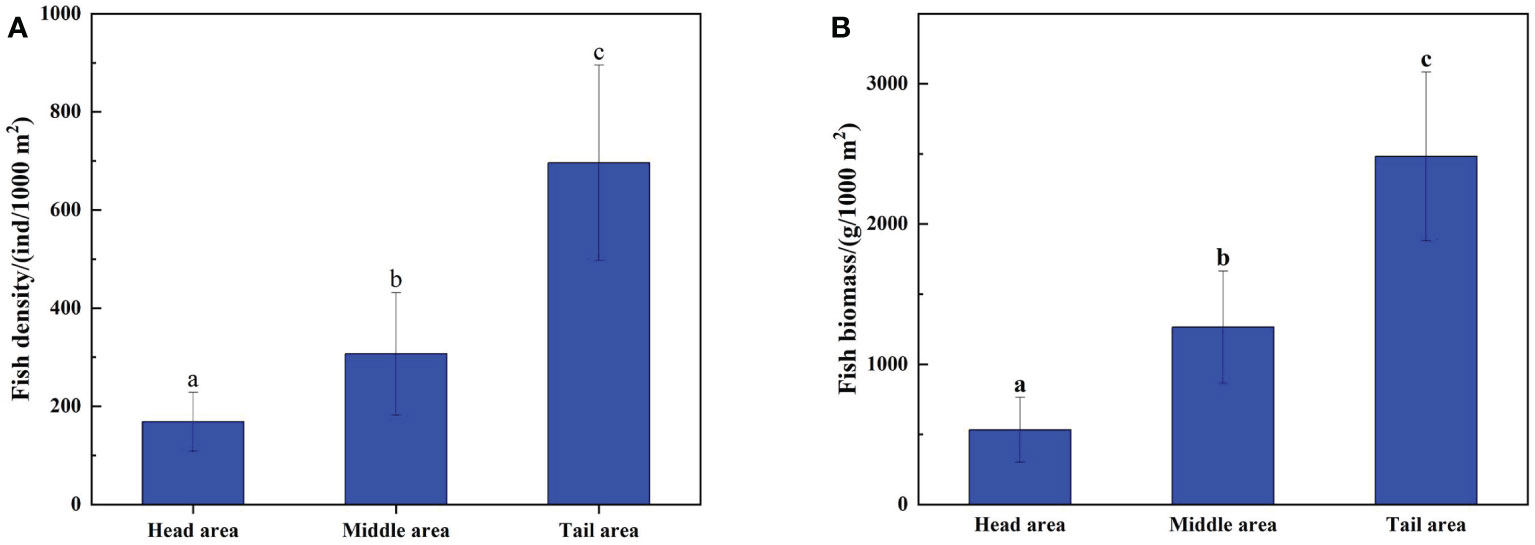
Figure 5 Horizontal distribution of the mean fish density [±SD, individuals/1,000 m2 (A)] and biomass [±SD, g/1,000 m2 (B)] in Yuwanghe Reservoir. Values with the same letters are not significantly different in different areas (P > 0.05); values with different letters are significantly different (P < 0.05).
3.4 Vertical distribution pattern of fish
Based on 3 m as the water layer according to the water depth of the reservoir, the proportion of fish density in different water layers in different areas of the reservoir to the sum of fish density in the entire water column was calculated as shown in Figure 5. The majority of the fish population was found in the water layer within the depth range of 0 to 12 m, where more than 97.3% of fish were distributed. In the water layer at depths of more than 12 m, the fish density tended to decrease gradually with the increase in water depth. However, differences were noted in the fish distribution pattern in the different areas of the reservoir along the vertical direction. Fish at the tail area preferred to move to the surface, and the proportion of fish in the depth range of 0 to 6 m was 81.5%; this proportion was higher than that at the head area (69.9%) and at the middle area (61.3%) (Figure 6). The reason for this difference may be the fact that the tail area of the reservoir has a shallow depth on average, and the fish were closer to the water surface. Consequently, the proportion of fish density in the surface waters was higher in the entire water column.
3.5 Relationship between fish distribution and environmental factors
According to Pearson correlation coefficient analysis, the main factors that influenced the fish distribution in Yuwanghe Reservoir were water depth (WD), water temperature (WT), dissolved oxygen (DO), total nitrogen (TN), and plankton (including zooplankton and phytoplankton) density (Figure 7). WT, DO, and plankton density were positively correlated with fish density, whereas WD was negatively correlated with fish density on the contrary. The pH, conductivity (Cond), total phosphorus (TP), ammonium nitrogen (NH4+–N), and chlorophyll a (Chl a) were not observed to have a significant connection with fish density.
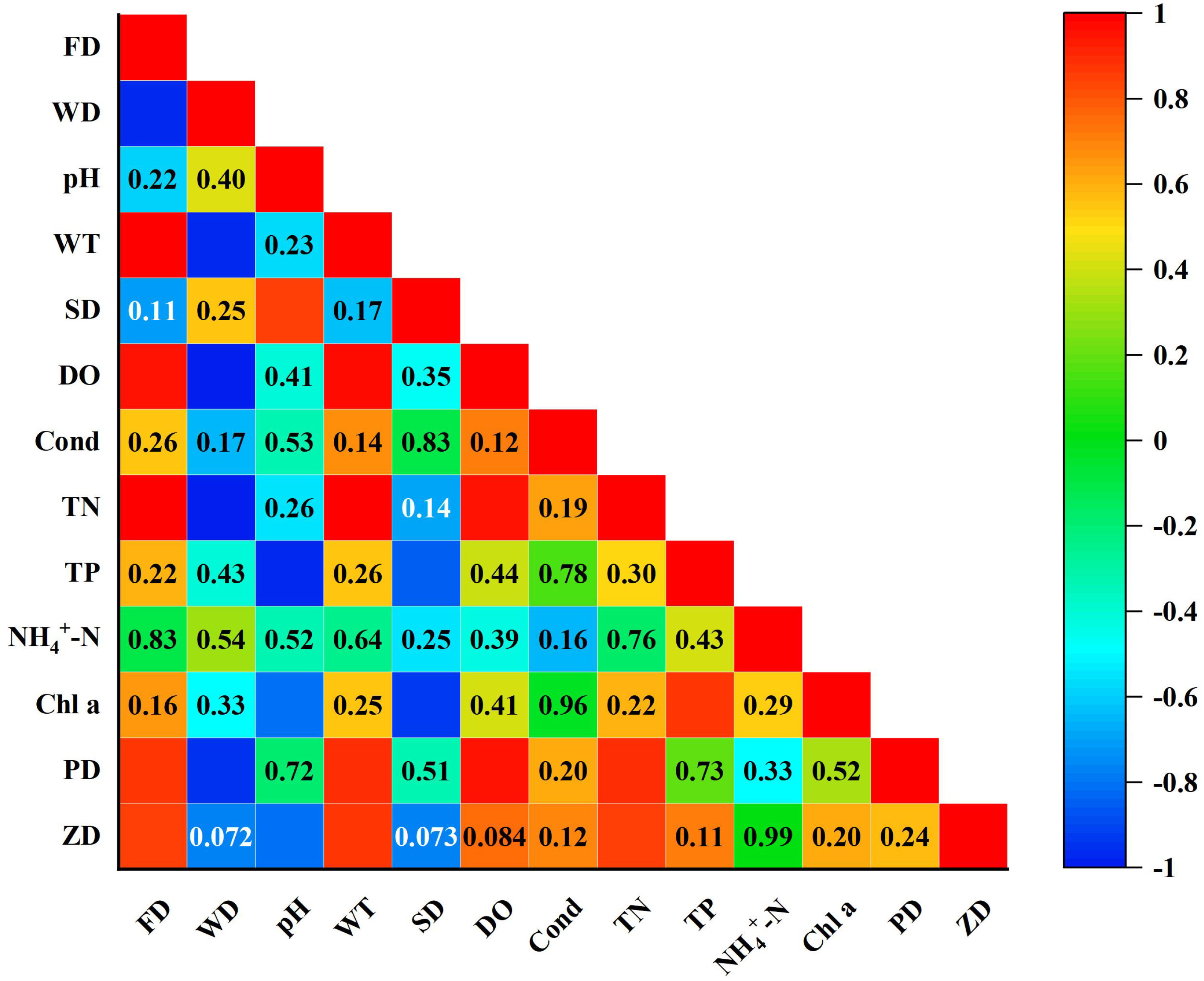
Figure 7 Pearson correlation between environmental factors and fish density. FD, fish density; WD, water depth; WT, water temperature; SD, Secchi disk depth; DO, dissolved oxygen; Cond, conductivity; TN, total nitrogen; TP, total phosphorus; NH4+–N, ammonia nitrogen; Chla, chlorophyll a; PD, phytoplankton density; ZD, zooplankton density. The different colors represent the size of the correlation coefficient; the number in the box is the P-value, and P <0.05 is not displayed (significant level is 0.05).
4 Discussion
4.1 Analysis of the fish community structure
From the survey data, only six species of fish were found in Yuwanghe Reservoir (Table 1). Regarding ecosystem stability, Yuwanghe Reservoir had fewer fish species, and the community structure was more based on a single species. Furthermore, the variety of trophic levels was poor, particularly for secondary consumers. A community with a very simple structure is extremely unstable and prone to retrograde succession under external interferences (Balazs et al., 2022; Wu et al., 2022). In terms of biological manipulation, the proportion of small fish in Yuwanghe Reservoir was too high. The hydroacoustic survey results showed the proportion of fish with a target strength of <–56 dB; accordingly, the proportion of fish with a total length of <100 mm was 92.9%. The proportion of fish with a total length of <100 mm in the collected fish catches was 96.3%, and the predominant species was topmouth gudgeon (P. parva). Zooplankton is an important prey population for small fish (Zhang, 2005; Liu et al., 2007; Lian et al., 2018). However, zooplankton feeds on phytoplankton, and the presence of a large number of small fish will result in a large decrease in zooplankton biomass in the water column, which is not favorable for controlling the phytoplankton biomass. Secondly, the absence of filter-feeding fish that feed on phytoplankton can easily lead to a massive growth of some algae under suitable conditions, which can trigger the occurrence of water blooms (Liu and Xie, 1999; Liu and Xie, 2003; Xie and Liu, 2001). Thirdly, because of the short generation cycle, early sexual maturity, and high reproductive capacity (Pollux and Korosi, 2006), topmouth gudgeon has been widely distributed in Central Asia, Europe, and North Africa in less than 50 years (Gozlan et al., 2010), and this fish species is listed as one of the most severe aquatic invasive species in Europe (Sala et al., 2000; Andreou et al., 2012) Following invasion into new areas, topmouth gudgeon poses a serious threat to the survival and reproduction of indigenous fish of the water bodies and can impair the stability of aquatic ecosystems by competing for food and habitat, carrying new diseases, and changing the characteristics of the habitat (Fletcher et al., 2016)— for example, topmouth gudgeon invasion in the Yunnan Plateau lakes led to the reduction or even extinction of many native fish species and a series of knock-on ecological effects (Chen et al., 1998; Yan and Chen, 2009). In the British Lake District, the whelk has become the most abundant fish in the region after 4 years of invasion, thereby threatening the survival of other native fish species (Britton et al., 2007). Unfortunately, there were too few carnivorous fish in the reservoir, and topmouth culter (Culter alburnus) was the only carnivorous fish species; its proportion in the catches was also extremely low, with a population share of only 1.01%. Moreover, topmouth culter prefers to inhabit the upper layers of the water column, while topmouth gudgeon inhabits the lower layers; this makes the topmouth culter population insufficient in gaining effective control over topmouth gudgeon in terms of energy conversion efficiency and habits.
4.2 Analysis of the fish distribution and its influencing factors
In the horizontal direction of Yuwanghe Reservoir, the fish densities and biomass showed a trend of gradual increase from the head area to the tail area of the reservoir; this trend was related to WT, DO, TN, and plankton feed from the correlation analysis between fish density and environmental factors (Figure 7). Although there was no significant difference in water temperature between the different areas of Yuwanghe Reservoir, the overall trend of a gradual increase in temperature from the head area to the middle area to the tail area of the reservoir was observed. Fish do not like to move in areas with low water temperatures; hence, the fish density tends to increase as they move further away from the dam. A similar result was reported by Prchalova et al. in their study on Rimov Reservoir (Prchalová, 2009). The DO and TN levels were another major cause of differences in fish horizontal densities. The inflowing river is located at the tail area of the reservoir, and the highest DO levels are found at the tail area of the reservoir where the water flows in. The DO concentration slowly decreased as the exogenous nutrient salts diffused away from the inlet river. As the predominant species in Yuwanghe Reservoir, topmouth gudgeon prefers to inhabit shallow waters (Asaeda and Manatunge, 2005; Asaeda and Manatunge, 2007). The shallow water area of Yuwanghe Reservoir provides the necessary habitat for P. parva, and it also has little risk of fish predation because of the low percentage of carnivorous fish. Consequently, fish density is higher in shallow waters than in deep water. Furthermore, the sampling survey of plankton in Yuwanghe Reservoir revealed that the horizontal distribution of plankton in the reservoir area showed a gradual increase from the head area to the tail area of the reservoir; thus, the difference in bait organisms was also a primary factor that led to a difference in the horizontal distribution pattern of fish in Yuwanghe Reservoir in the present study.
Vertically, most of the fish in Yuwanghe Reservoir were distributed in the water layer within a depth of 0 to 12 m, and the fish density tended to decrease gradually with the increase in water depth. Some studies have been conducted on the distribution of fish density or biomass in different water layers. Mou et al. (2012) surveyed Hongfeng Lake, a large deep lake, by using the hydroacoustic method, and they found significant differences in fish density in different water layers, and the fish density gradually decreased with an increase in water depth. Lian et al. (2018) reported that more than 97.6% of fish were distributed in the water layer within the depth range of 0 to 10 m in a hydroacoustic study of deep-water reservoirs in Yunnan Plateau. Zhou et al. (2021) showed a negative correlation between fish density distribution and water depth in Hongchaojiang Reservoir. The results of the present study agreed with those of former studies. Fish lack the ability to regulate body temperature, and most warm-water fish prefer a suitable water temperature of 20 to 30°C; consequently, the either too high or too low water temperature will affect the growth and movement of fish (Yin, 1995). Hence, most fish tend to stay away from the water layer below the thermocline, while zooplanktons—which is the food of most fish —are mainly distributed in the water layer above the thermocline (Lian et al., 2018). DO is also an important factor that affects the vertical distribution of fish. In general, DO concentration in the deep-water reservoir gradually decreases as the water depth increases; thus, fish will actively migrate to avoid low-oxygen or anoxic water (He and Cai, 1998; Lian et al., 2018). It was also the reason why most fish species were distributed in the upper water layer in the present study.
5 Conclusion
Yuwanghe Reservoir is a typical plateau deep-water reservoir in the early impoundment stage. Presently, although the quality of water is good and the phytoplankton biomass level is low, its biological community structure is relatively homogeneous, and topmouth gudgeon is the dominant species. There are serious concerns regarding the invasion of topmouth gudgeon into plateau lakes, which would severely affect the stability of water ecosystems (Chen et al., 1998). Typical examples include Tien Lake, Lake Erhai, and Fuxian lake in Yunnan, where the population of many indigenous fish species is declining or endangered because of the invasion of topmouth gudgeon (Yan and Chen, 2009; Li et al., 2017). In the absence of artificial control of the topmouth gudgeon population, the survival environment of indigenous fish in Yuwanghe Reservoir and the surrounding waters will be threatened, and a series of chain ecological effects will occur, which will be easily affected by human activities around the reservoir area, resulting in the occurrence of water deterioration events, such as eutrophication, in the future. We also found that the proportion of carnivorous fish was too low, which cannot control the population of topmouth gudgeon under natural conditions. Therefore, native carnivorous fish should be introduced to control the size of the small fish population to adjust the fish community structure; this can reduce the feeding pressure of small fish on zooplankton and thus control the phytoplankton population. Moreover, because of the current lack of filter-feeding fish, the reservoir should be appropriately increased, and silver and bighead carp should be released in the reservoir. This will strengthen the filter-feeding effect on plankton to prevent their proliferation and thus cause a competitive environment in the reservoir and also yield certain economically beneficial effects.
Data availability statement
The original contributions presented in the study are included in the article/supplementary material. Further inquiries can be directed to the corresponding author.
Ethics statement
This study was reviewed and approved by Research Ethics Committee of Institute of Hydrology, Chinese Academy of Sciences.
Author contributions
BL (co- first author): investigation, data curation, methodology, formal analysis, and writing—original draft. XZ (co- first author): data curation, methodology, writing—review and editing, and project administration. CZ: investigation, data curation, and writing—review and editing. JB: investigation, data curation, and writing—review and editing. FM: investigation, data curation, and writing—review and editing. YL: writing—review and editing. DZ: investigation and data curation. SH: investigation and data curation. LG: writing—review and editing. MD: conceptualization, writing—review and editing, and project administration. All authors contributed to the article and approved the submitted version.
Funding
This work was financially supported by the Guizhou Province Science and Technology Support Plan (numbers 2022129 and 2022165), the Science and Technology Poverty Alleviation Program of the Chinese Academy of Sciences (number KFJ-FP-202102), the National Natural Science Foundation of China (numbers 32202914 and 32172955), the National Key R and D Program of China (number 2022YFB 3206903), the Scientific Instrument Developing Project of the Chinese Academy of Sciences (number YJKYYQ 20190055), and the Special Program for the Institute of National Parks of the Chinese Academy Sciences (number KFJ-STS-ZDTP-2021-003).
Acknowledgments
The authors thank the vessel crew and staff at Guizhou Province Reservoir Operation and Management Corporation in Liupanshui for their collaboration.
Conflict of interest
The authors declare that the research was conducted in the absence of any commercial or financial relationships that could be construed as a potential conflict of interest.
Publisher’s note
All claims expressed in this article are solely those of the authors and do not necessarily represent those of their affiliated organizations, or those of the publisher, the editors and the reviewers. Any product that may be evaluated in this article, or claim that may be made by its manufacturer, is not guaranteed or endorsed by the publisher.
References
Andreou D., Arkush K. D., Guégan J. F., Gozlan R. E. (2012). Introduced pathogens and native freshwater biodiversity: a case study of sphaerothecum destruens. PloS One 7, e36998. doi: 10.1371/journal.pone.0036998
Anne M., Chloe G., Thomas A., Helge B., Anne L. D., Malgorzata G., et al. (2019). Including 38 kHz in the standardization protocol for hydroacoustic fish surveys in temperate lakes. Remote sens. Ecol. conserv. 5, 332–345. doi: 10.1002/-rse2.112
Asaeda T., Manatunge J. (2005). Foraging of a small planktivore (Pseudoras-bora parva: Cyprinidae) and its behavioral flexibility in an artificial stream. Hydrobiol. 549, 155–166. doi: 10.1007/s10750-005-5442-1
Asaeda T., Manatunge J. (2007). ). physiological responses of topmouth gudge-on, Pseudorasbora parva, to predator cuesand variation of current velocity. Aquat. Ecol. 2007, 41, 111–118. doi: 10.1007/s10452-006-9048-0
Balazs K. R., Munson S. M., Butterfield B. J. (2022). Functional composition of plant communities mediates biomass effects on ecosystem service recovery across an experimental dryland restoration network. Funct. Ecol. 36, 2317–2330. doi: 10.1111/1365-2435.14129
Britton J. R., Davies G. D., Brazier M., Pinder A. C. (2007). A case study on the population ecology of a topmouth gudgeon (Pseudorasbora parva) population in the UK and the implications for native fish communities. Aquat. Conserv. Mar. Freshw. Ecosyst. 17, 749—759. doi: 10.1002/aqc.809
Bureau of Fisheries (2021). “Ministry of agriculture and rural affairs,” in China Fishery statistical yearbook (Beijing: China: Agriculture Press).
Chen Y. R., Yang J. X., Li Z. Y. (1998). The diversity and present status of fishes in yunnan province. Chin. Biodiversity. 6, 272–277.
Drastik V. M., Godlewska H., Balk P., Clabburn J., Kubecka E., Morrissey, et al. (2017). Fish hydroacoustic survey standardization: a step forward based on compareso-ns of methods and systems from vertical surveys of a large deeplake. Limnol. Oceanogr. Methods 15, 836–846. doi: 10.1002/lom3.10202
Esri (2013). ArcGIS 10.2. a GIS software for discovering, consuming, creating, and sharing geographic data, maps, and apps designed to fulfill particular objectives (California, USA). Available at: https://www.esri.com/en-us/home.
Fletcher D. H., Gillingham P. K., Britton J. R., Blanchet S., Gozlan R. E. (2016). Predicting global invasion risks: a management tool to prevent future introductions. Sci. Rep. 1, 26316. doi: 10.1038/srep26316
Frouzova J., Kubecka J., Balk H., Frouz J. (2005). Target strength of some european fish species and its dependence on fish body parameters. Fish. Res. 75, 86–96. doi: 10.1016/j.fishres.2005.04.011
Godlewska M., Świerzowski A., Winfield I. J. (2004). Hydroacoustics as a tool for studies of fish and their habitat. Ecohydrol. Hydrobiol. 4, 417–427.
Gozlan R. E., Britton J. R., Cowx I., Copp G. H. (2010). Current knowledge on non-native freshwater fish introductions. J. Fish Biol. 76, 751–786. doi: 10.1111/j.1095-8649.2010.02566.x
Guillard J., Simier M., Albaret J. J., Raffay J., Sow I., Tito M. L. (2012). Fish biomass estimates along estuaries: A comparison of vertical acoustic sampling at fixed stations and purse seine catches. Estuar. Coast. Shelf Sci. 107, 105–111. doi: 10.1016/j.ecss.2012.05.022
Guo A. H., Liu J. D., Yuan J. L., Hao Y. B., Xin J. M., Gu Z. M. (2018). Assessment of stock enhancement performance in reservoir using hydroacoustic method. Fish. Sci. 37, 201–207. doi: 10.16378/j.cnki.1003-1111.2018.02.009
Guo L., Wang Q., Xie P., Tao M., Zhang J., Niu Y., et al. (2015). A non-classical biomanipulation experiment in gonghu bay of lake taihu: Control of microcystis blooms using silver and bighead carps. Aquacult. Res. 46, 2211–2224. doi: 10.1111/are
Han B. P. (2010). Reservoir ecology and limnology in China: a retrospective comment. J. Lake Sci. 22, 151–160.
He L. (2016). Investigation on present situation of fishery resources in tongwan reservoir (Changsha: Hunan Agriculture University).
Huang G., Wang Q. D., Chen X. H., Godlewska M., Lian Y. X., Yuan J., et al. (2019). Evaluating impacts of an extreme flood on a fish assemblage using hydroacoustics in a large reservoir of the Yangtze river basin, China. Hydrobiologia. 841, 31–43. doi: 10.1007/s10750-019-04003-4
Jutagate T., Sawusdee A. (2022) Catch composition and risk assessment of two fishing gears used in small-scale fisheries of bandon bay, the gulf of Thailand. Peer J. doi: 10.10.7717/peerj.13878
Kubečka J., Hohausova E., Matena J., Peterka J., Amarasinghe U. S., Bonar S. A., et al. (2009). The true picture of a lake or reservoir fish stock: A review of needs and progress. Fish. Res. 96, 1–5. doi: 10.1016/j.fishres.2008.09.021
Li H. J., Wang Y. P., Leng Q. L., Li X. J., Li X. F., Yu T. L., et al. (2017). Study on the age and growth of Pseudorasbora parva from nanwan lake upstream the huaihe river. Acta Hydrobiol. Sinca. 41, 835–842. doi: 10.7541/2017.104
Li H. F., Zhang H., Yu L. X., Cao K., Wang D. Q., Duan X., et al. (2022). Managing water level for Large migratory fish at the poyang lake outlet: Implications based on habitat suitability and connectivity. Water. 14, 2076. doi: 10.3390/w14132076
Lian Y. X., Huang G., Godlewska M., Li C., Zhao X., Ye S. W., et al. (2015). Hydroacoustic assessment of spatio-temporal distribution and abundance of fish resource in the xiangxi river. Acta Hydrobiol. Sinca. 39, 920–929.
Lian Y. X., Li C., Ye S. W., Li W., Liu J. ,. S., Li Z. ,. J. (2018). Fish spatial distribution patterns and controlling factors in yudong reservoir, yunnan plateau. J. Lake Sci. 30, 1755–1765. doi: 10.18307/2018.0626
Lian Y. X., Ye S. W., Godlewska M., Huang G., Wang J. C., Liu J. S., et al. (2022). Comparison of two types of survey designs for acoustic estimates of fish resources in the three gorges reservoir, China. Water. 14, 2745. doi: 10.3390/w14172745
Liu E. S., Bao C. H., Wu L. K., Cao P. (2007). Comparison of food composition and analysis on mutual effects between Neosal anx tangkah-keii taihuensis chen and Coilia ecten taihuensis yen et lin in lake taihu. J. Lake Sci. 19, 103–110. doi: 10.18307/2007.0116
Liu J. K., Xie P. (1999). Unraveling the enigma of the disappearance of water bloom from the East lake (Lake donghu) of wuhan. Resour. Environ. Yangtze Basin. 8, 312–319.
Liu J. K., Xie P. (2003). Direct control of microcystis bloom through the use of planktivorous carp-closure experiments and lake fishery practice. Ecol. Sci. 22, 193–196.
Liu Q. G., Zhang Z. (2016). Controlling the nuisance algae by silver and bighead carps in eutrophic lakes: disputes and consensus. Lake Sci. 28, 463–475. doi: 10.18307/2016.0301
Lv H. (2019). Study on sources and migration characteristics of heavy metals in water and suspended particulates of aha reservoir, guizhou province (Tianjin: Tianjin University), 0043–0012. doi: 10.27356/d.cnki.gtjdu.2019
Maclennan D. N., Simmonds E. J. (2005) Fisheries acoustics: Theory and practice. (Oxford: Blackwell Science). doi: 10.1002/9780470995303
Matthias E., Ian J. W., Winfield J. G., Jean G., Atle R., Charlotte V., et al. (2012). Strong correspondence between gillnet catch per unit effort and hydroacoustically derived fish biomass in stratified lakes. Freshw. Biol. 57, 2436–2448. doi: 10.1111/fwb.12022
Mou H. M., Yao J. J., Ni C. H., Fang G. Z., An M., Ma S. (2012). Hydroacoustic survey of fish resource and spatial distribution in hongfeng lake. S. China Fish. Sci. 8, 62–69.
OriginLab (2021). OriginPro: A software for data analysis and graphing (Massachusetts, USA). Available at: https://www.originlab.com.
Ou T. (2015). Dynamic changes of phytoplankton community structure and its affecting factors in three reservoir of guizhou plateau (Guiyang: Guizhou Normal University).
Pollux B. J. A., Korosi A. (2006). On the occurrence of the Asiatic cyprinid Pseudorasbora parva in the Netherlands. J. Fish Biol. 69, 1575–1580. doi: 10.1111/j.1095-8649.2006.01218.x
Prchalová M., Kubečka J., Čech M., Frouzová J., Draštík V., Hohausová E., et al. (2009). The effect of depth, distance from dam and habitat on spatial distribution of fish in an artificial reservoir. Ecol. Freshw. Fish. 18, 247–260. doi: 10.1111/j.1600-0633.2008.00342.x
Ricker W. E. (1975). Computation and interpretation of biological statistics of fish populations. Bull. Fish. Res. Board Can. 191, 1–382.
Sala O. E., Chapin F. S., Armesto J. J., Berlow E., Bloomfield J., Dirzo R., et al. (2000). Global biodiversity scenarios for the year 2100. Sci. 287, 1770–1774. doi: 10.1126/science.287.5459.1770
Samedy V., Wach M., Lobry J., Selleslagh J., Pierre M., Josse E., et al. (2015). Hydroacoustics as a relevant tool tomonitor fish dynamics in large estuaries. Fish. Res. 172, 225–223. doi: 10.1016/j.fishres.2015.07.025
Winfield I. J., Bean C. W., Gorst J., Gowans A. R. D., Robinson M., Thomas R. (2013). Assessment and conservation of whitefish (Coregonus lavaretus) in the UK. Adv. Limnol. 64, 305–321. doi: 10.1127/1612-166X/2013/0064-0023
Wu W. J., Yang K., Wang Z. C., Li G. B., Liu Y. D. (2012). Community structure and seasonal succession of phytoplankton in yudong reservoir of yungui plateau. J. Hydroecol. 33, 69–75. doi: 10.15928/j.1674-3075.2012.02.005
Wu J. X., Yang H. Q., Yu W., Yin C., He Y., Zhang Z., et al. (2022). Effect of ecosystem degradation on the source of particulate organic matter in a karst lake: A case study of the caohai lake, China. Water. 14, 1867. doi: 10.3390/w14121867
Xie S. G., Cui Y. B., Li Z. J. (2003). Studies on resource utility patterns of lake fish communities: progress and methods. Acta Hydrobiol. Sinca. 27, 78–84.
Xie P., Liu J. K. (2001). Practical success of biomanipulation using filter-feeding fish to control cyanobacteria blooms: A synthesis of decades of research and application in a sub-tropical hypereutrophic lake. Sci. World. 1, 337–356. doi: 10.1100/tsw.2001.67
Yan Y., Chen Y. (2009). Variations in reproductive strategies between one invasive population and two native populations of Pseudorasbora parva. Curr. Zoology. 55, 56–60. doi: 10.1093/czoolo/55.1.56
Ye S. W., Li Z. ,. J., Feng G. P., Cao W. (2007). Length-weight relationships for thirty fish species in lake niushan, a shallow macrophytic Yangtze lake in China. Asian Fish. Sci. 20, 217–226. doi: 10.33997/j.afs.2007.20.2.007
Zhang T. L. (2005). Life-history strategies, trophic patterns and community structure in the fishes of lake biandantang (Wuhan: Institute of Hydrobiology, Chinese Academy of Sciences).
Zhang J. M., He Z. H. (1991). Inland waters fisheries natural resources survey manual. (Beijing: China Agriculture Press).
Keywords: fish communication structure, spatial distribution, reservoir, early impoundment stage, hydroacoustic
Citation: Luo B, Zhou X, Zhang C, Bao J, Mei F, Lian Y, Zhang D, Hu S, Guo L and Duan M (2023) Hydroacoustic survey on fish spatial distribution in the early impoundment stage of Yuwanghe Reservoir in southwest China. Front. Mar. Sci. 10:1119411. doi: 10.3389/fmars.2023.1119411
Received: 08 December 2022; Accepted: 23 January 2023;
Published: 09 February 2023.
Edited by:
Ce Shi, Ningbo University, ChinaCopyright © 2023 Luo, Zhou, Zhang, Bao, Mei, Lian, Zhang, Hu, Guo and Duan. This is an open-access article distributed under the terms of the Creative Commons Attribution License (CC BY). The use, distribution or reproduction in other forums is permitted, provided the original author(s) and the copyright owner(s) are credited and that the original publication in this journal is cited, in accordance with accepted academic practice. No use, distribution or reproduction is permitted which does not comply with these terms.
*Correspondence: Ming Duan, ZHVhbm1pbmdAaWhiLmFjLmNu
†These authors share first authorship
 Bin Luo1,2†
Bin Luo1,2† Longgen Guo
Longgen Guo Ming Duan
Ming Duan